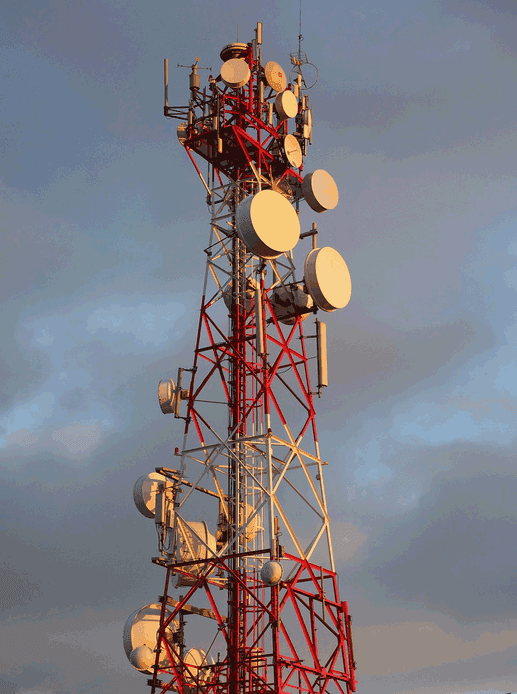Communication tower plays an extremely important role in the modern communication network system and is one of the key infrastructures to ensure that we can communicate smoothly anytime and anywhere.
“Type”
“Angle steel tower”: This is a relatively traditional and common type of communication tower. It is mainly assembled by angle steel through bolts or welding. The structure is relatively stable and can withstand a large load. It is suitable for a variety of different terrains and environments. For example, in some open plain areas and places with relatively conventional natural conditions such as wind, angle steel towers are often seen standing there, used to carry communication antenna equipment of operators such as China Mobile, China Unicom, and China Telecom, and provide signal coverage for surrounding areas.
“Single-tube tower”: The shape is presented as an independent circular or polygonal steel pipe structure, and the appearance is relatively simple. It has the advantage of a small footprint. Therefore, in some places in the city where land resources are relatively tight, such as city corners and around small squares, it is often selected to install communication equipment to meet the communication needs of local areas in the city without occupying too much limited urban space.
“Landscape tower”: This is a communication tower that combines functionality and aesthetics. Its design will incorporate local cultural elements, natural features and other characteristics, so that its shape may look like a big tree, a sculpture or other artistic shapes. It is widely used in places that pay attention to environmental beauty such as parks, scenic spots, and cultural blocks. It can not only complete the task of communication signal coverage but also complement the surrounding environment and become a unique landscape.
“Bionic tree communication tower”: As the name suggests, this type of communication tower imitates the shape of a tree and has structures such as tree trunks and branches. From a distance, it looks like a real tree. It has good concealment and is especially suitable for places where the surrounding environmental features are strictly required and communication facilities are not expected to be too obtrusive, such as the edges of some nature reserves and inside high-end residential areas. While ensuring communication functions, it maintains the original landscape effect to the greatest extent.
“Function”
“Signal coverage enhancement”: The primary function of a communication tower is to provide a suitable height position for communication antennas so that the wireless signals emitted by the antennas can spread farther and cover a wider range. For example, in mountainous areas, by building communication towers on higher mountain tops or suitable locations, remote villages, valleys and other areas with weak or even no signals can receive stable mobile network signals, facilitating local residents to contact the outside world and also conducive to promoting local economic, cultural and other aspects of development.
“Ensuring communication quality”: Installing communication equipment on communication towers can reduce the interference of surrounding buildings, terrain and other factors on signal transmission, ensure the transmission quality of signals, and reduce the occurrence probability of signal attenuation and distortion. Thus, users can experience more smooth and stable communication services such as making calls and surfing the Internet.
“Supporting multiple communication services”: Whether it is our daily mobile phone calls, text messaging functions, or mobile data surfing, data transmission of Internet of Things devices, etc., they all rely on communication towers to carry corresponding communication equipment to realize the normal development of different services and meet people’s diverse communication needs and the usage needs of communication networks in various industries.
“Construction and maintenance requirements”
“Construction aspect”:
“Site selection and planning”: Multiple factors such as topography, surrounding population distribution, signal coverage needs, and land nature should be comprehensively considered. For example, it is necessary to avoid selecting areas with unstable geological conditions where disasters such as landslides and collapses are prone to occur. At the same time, it is also necessary to consider whether the selected location can optimize the signal coverage range to the greatest extent and also meet the relevant requirements of local urban planning and land use planning.
“Structural design and construction”: Scientific and reasonable structural design needs to be carried out according to the meteorological conditions (such as maximum wind speed, icing thickness, etc.) of the communication tower’s location and the weight of the communication equipment expected to be mounted to ensure that the communication tower has sufficient strength and stability. During the construction process, operations must be carried out in strict accordance with relevant engineering specifications and quality standards to ensure that the installation quality and welding quality of each component meet the standards.
“Maintenance aspect”:
“Regular inspections”: Arrange professional personnel to conduct on-site inspections of communication towers regularly to check whether there is deformation, corrosion, loose bolts, etc. in the tower structure, and whether the connection of communication equipment such as antennas is firm and operating normally. Once problems are found, corresponding repair and reinforcement measures should be taken in time.
“Anti-corrosion and rust prevention treatment”: Since communication towers are exposed to the external environment for a long time and are easily eroded by wind and rain, regular anti-corrosion and rust prevention treatment is required, such as painting anti-corrosion paint, etc., to extend the service life of communication towers and ensure their long-term stable and reliable operation.
Sale!
Communication tower
Communication tower
Original price was: $3,000.00.$2,850.00Current price is: $2,850.00.
& Free Shipping“Communication tower” usually refers to a towering structure used to support communication antennas and communication equipment for transmitting and receiving wireless signals.
| Weight | 1000 kg |
|---|




Reviews
There are no reviews yet.